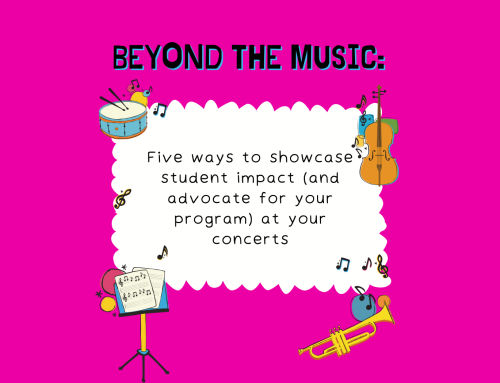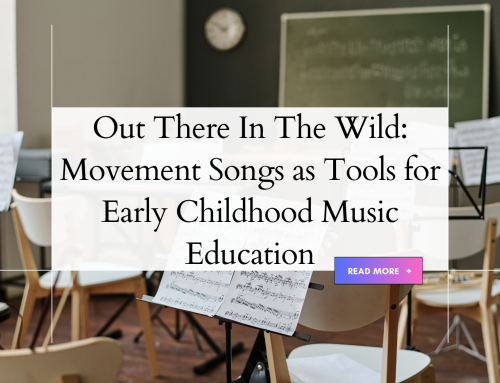
Table of Contents
My Background
In high school, I had a thing for guitar players. I remember playing in a cover band (I was the keyboardist), amazed at how my guitar player would pick up melodies by ear and translate them to his instrument. I loved watching videos of Joan Jett and other female guitarists but was too intimidated to pick up a guitar myself. Why? I was a classically trained pianist trying to become a pop keyboard player. I was used to being told what to play and how to play it. This didn’t seem to fit with the style of guitar I wanted to play and it overwhelmed me. So, I left guitar playing to the “pros” and continued on to music school to get a degree in music education with a piano concentration.
Welcome to the Jungle
I was informed that I would be teaching a high school beginning guitar elective (WHAT?!). Terrified, I looked to my co-workers for curricular resources.
I started teaching in 2007 at a suburban middle and high school outside of Philadelphia, PA. During my first meeting with the rest of the music staff, I was informed that I would be teaching a high school beginning guitar elective (WHAT?!). Terrified, I looked to my co-workers for curricular resources. I found some books on teaching guitar in the closet of my classroom… from 1975. There were also some VHS tapes on teaching classical guitar. I was stuck. I asked for help and fumbled my way through that first year, staying one step ahead of my students. When I started teaching, I could only play 3 chords and had never used a pick before. By the end of the year, I could play a dozen chords and strum my way through “Surfin’ USA.” Things were looking up.
The Problem
As a pre-service teacher educator, I notice how we neglect guitar instruction in higher education. We expect our undergraduate students to play etudes on nearly every single wind instrument but don’t give them functional guitar skills. Functional piano skills? Maybe. But, most schools don’t require future music educators to know how to play the guitar. Why is this a problem? Guitar classes are becoming increasingly prevalent in schools and many secondary level general music teachers are now offering guitar or ukulele as part of the curriculum. Modern band programs are popping up throughout the country (thanks to organizations such as Little Kids Rock and Musical Futures) and we need teachers who feel equipped to teach guitar.
Most of the students who want to play guitar are not looking to play classical etudes. They want to play rock. They want to play pop.
The other problem? Most of the students who want to play guitar are not looking to play classical etudes. They want to play rock. They want to play pop. And, we don’t have much in terms of curriculum: resources that are relevant and adaptable to different populations and musical preferences.
My Education
Instead of referencing the guitar books from the 70’s or the methods that emphasized note reading over playing, I looked elsewhere for how to develop a guitar program and become a better guitarist. Mostly, I asked the guitarists I played with: How did you become a better guitarist? What skills did you need to work on to become a better player? What resources did you use? I watched YouTube tutorials, I read books. I practiced. Among other ideas, here are some of my main takeaways from building a beginning guitar program:
- Define your end goal for students.
What is the purpose of your program? For me, it is to develop lifelong musicians. This means I have to craft a curriculum that helps my students become autonomous, well-rounded music makers. It also means that the type of sound preservation (notation or tabs, etc.) I use in class and the songs we play will change as interests and technology changes. - Embrace non-linear ways of learning.
In the Western Classical tradition, teachers or conductors are expected to teach in a very prescriptive, linear way. I find that every guitarist I collaborate with capitalizes on their own strengths to learn. Whether through listening, watching YouTube tutorials, or reading lead sheets, I recognize that students need many different ways to engage with materials. AND, learning looks different for each person! I try to keep each class varied in terms of personal practice, collaborative playing, demonstrations, and listening. - You don’t have to be the best guitarist in the room.
Now that I’ve been teaching guitar for 12 years, I realize that many of my students will be better than me. This isn’t a bad thing! When I let students be the experts of their domain and teach me, it is much easier to develop trust and community in my guitar classroom. I always work alongside them, share my personal practice, and try to keep getting better. (Taking lessons and classes is also so helpful! Check out the classes you can take on Berklee’s online program. I highly recommend the “Acoustic Guitar Technique” class.) - Remember the power of music.
I remember when one of my student’s parents came to me on Back to School night. “Matt told me that you cried when he played his final song for guitar class,” she said. I was so surprised to hear that (especially because I thought I covered my crying pretty well)—to know that her son noticed my reaction and that it meant something to him. My guitar students remind me daily of the power of music. Kids who had no hobbies prior to our class, who lacked community, now spend each day playing guitar outside my classroom and making friends with other musicians. I get to watch students sing and play guitar for the first time to a supportive audience. I get to watch kids play a song they love for the first time! What an honor. Truly. Teaching guitar has impacted me in ways that are different from the other music classes I teach.
Moving Forward
I plan to keep learning and growing, to keep meeting student right where they are at. One of the ways I do this is to provide multiple access points for students so that we can all play together on a regular basis, no matter how quickly they are progressing through our materials.
Want to know more about how I provide multiple access points for students? You can check out this free video that is part of large body of resources that come with my book, The Comprehensive Beginning Guitar Curriculum.
Want to hear my favorite original guitar riff? Check out Cold Bread by my former band, Turning Violet Violet. Jeff Scott is the lead guitarist in this recording and I owe a lot of what I know about guitar playing to him.
Get Sarah’s book here:
INCLUDES:
• video examples
• classroom handouts
• assessments
• a space for typing notes directly into the PDF






Leave A Comment